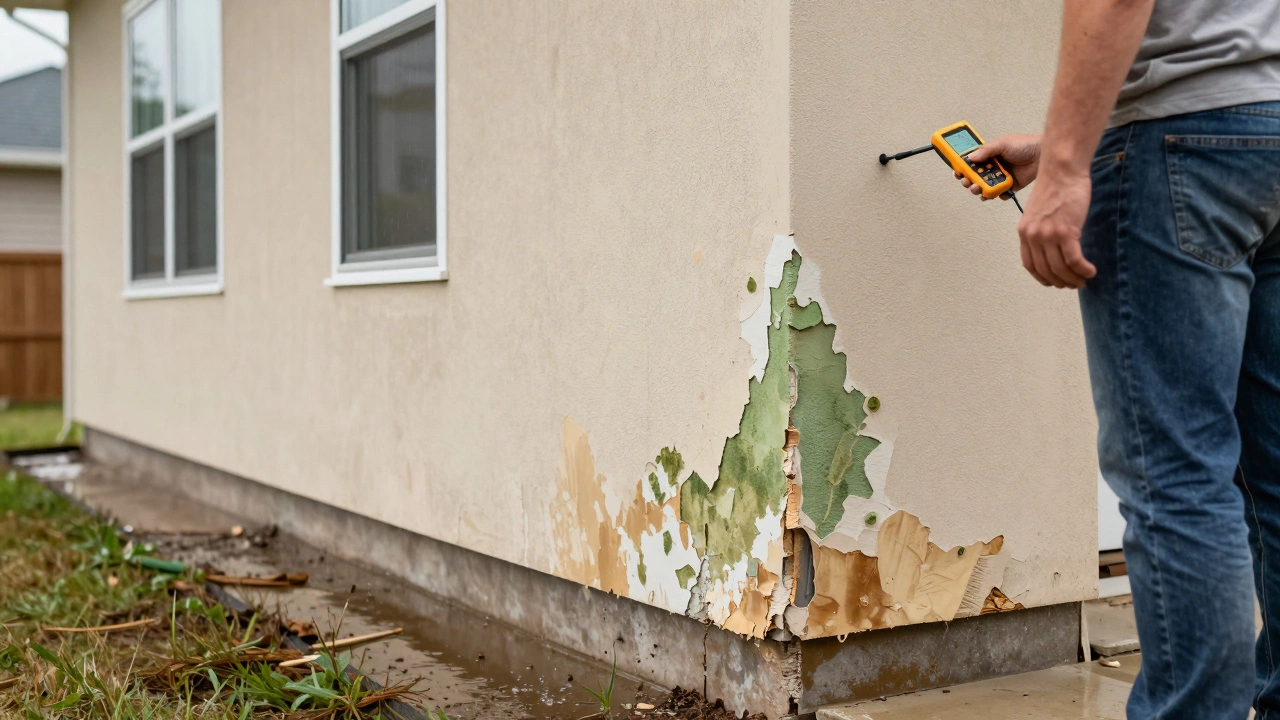Ever moved into a brand-new place, only to find cracks in the walls or a window that just won’t shut? That’s where the idea of a ‘defect’ in a new build starts making sense. Basically, a defect is anything in a new home that isn’t up to scratch, either because it doesn’t match what the builder promised, or because it isn’t safe or legal. But not every issue is a big deal—some things are fixes, others are bigger headaches.
Spotting defects early saves money and stress. You’d be surprised—bad paint jobs, loose door handles, even leaking showers are common in new homes as builders sometimes rush to hit deadlines. A recent survey in the UK found that nearly 98% of new owners discovered at least one issue after moving in. That's why keeping your eyes peeled and knowing what counts as a real defect is key.
- Defining a New Build Defect
- The Most Common Defects Homeowners Spot
- Snagging vs Serious Defects: What’s the Difference?
- What to Do If You Spot a Defect
- Tips for Avoiding Major New Build Headaches
Defining a New Build Defect
So, what exactly is a defect in a new build? In plain terms, it’s something that isn’t right, doesn’t work as promised, or breaks building rules. It could be as obvious as a broken window or as hidden as dodgy wiring behind the walls. A defect isn’t just annoyances like scuffed paint—it’s anything that means your new home isn’t up to the standards set by the builder, building codes, or your contract. Houses should be safe, finished to the specs you agreed on, and fully working before you move in.
The new build world has a few types of defects. Minor ones are often called “snags” and include things like chipped tiles or missing door handles. Then you have “major” defects, such as a leaking roof, faulty electrics, or uneven floors. Building regulations in places like the UK and Australia make it clear: by law, new homes must meet minimum safety and quality standards. These are not optional, and if something fails here, it becomes a defect—no excuses allowed.
Defects often show up because of rushed work, missed steps in the building process, or materials that weren’t up to scratch. Even the best builders get things wrong sometimes, especially when they’re cranking out dozens of homes a month. That’s why new builds come with warranties that cover certain problems for 2, 5, or even 10 years depending on where you live. These warranties have lists of what counts as a defect and what’s just regular wear and tear, so always read the paperwork.
To sum it up, a defect in your new home is any problem that means your place isn’t finished properly, doesn’t meet safety rules, or doesn’t match what you paid for. Knowing what counts as a defect helps you spot stuff early and hold your builder accountable before it turns into a nightmare.
The Most Common Defects Homeowners Spot
When people imagine moving into a brand new home, they expect everything to be flawless. But that's rarely the reality. Most new builds come with a list of annoying snags—stuff that either feels unfinished or just isn’t working right out of the gate. Some are small enough to shrug off, but others can make daily life a pain until they're sorted.
The most common problems fall into a few categories. Here’s what homeowners say pops up again and again:
- Bad finishing touches: Messy paintwork, uneven plaster, or spots that didn’t get a second coat.
- Doors and windows: Maybe they stick, don’t shut right, or rattle in the wind.
- Plumbing issues: Leaky pipes under sinks, taps that wobble, or toilets that don’t flush as they should.
- Problems with electrics: Power sockets not working, loose faceplates, or flickering lights.
- Floors: Squeaky boards, cracked tiles, or carpet that feels loose at the edges.
- Heating glitches: Radiators that stay stone-cold, weird noises from the boiler, or uneven heating between rooms.
- Outside stuff: Guttering that leaks, paths that puddle, or fences that already look wobbly.
How often do these pop up? It’s not just a few unlucky buyers. Look at this table based on a 2023 survey of over 2000 new build homeowners in the UK:
| Defect Type | % of Homeowners Affected |
|---|---|
| Cosmetic (paint, plaster, finish) | 82% |
| Doors & Windows | 69% |
| Plumbing | 41% |
| Electrics | 35% |
| Flooring | 29% |
| Heating Systems | 21% |
| External works | 31% |
These aren’t just minor headaches—they’re the new build problems you’re most likely to run into. If anything feels dodgy, take photos and make a list. Most builders will fix genuine defects if you catch them within your warranty period. Don’t just put up with problems because they seem common—if it isn’t right, it deserves attention!

Snagging vs Serious Defects: What’s the Difference?
Not all problems in a new home are created equal. There’s a big gap between a scratch on a window ledge and a leak pouring through your ceiling. That’s where the terms "snagging" and "serious defects" come in—and knowing the difference really matters if you want stuff fixed quickly.
Snagging covers all those minor issues most people spot when they first move in. Think unfinished paintwork, a cupboard door not lining up, or a wonky kitchen tile. These won’t put your safety at risk, but they’re annoying and sloppy. Most builders expect you to create a snagging list during the first few weeks of moving in so they can send someone to patch things up. Usually, the builder is legally required to fix these, especially if reported within the first few months.
- Cracked tiles
- Paint splatters or missed spots
- Dripping taps
- Loose sockets or handles
- Sticky doors or windows
Serious defects are a whole different story. These are big problems that can cause real damage, cost a lot to fix, or make the home unsafe. Examples include structural cracks, roof leaks, dodgy wiring, plumbing that floods your floor, or missing insulation. These can affect how you live in the house, and sometimes even break building regulations. If you spot one of these, you need to push the builder hard—or even turn to your warranty provider.
- Major cracks in walls or ceilings
- Roof leaks
- Electrical system faults
- Plumbing faults causing damp or flooding
- Poor insulation or missing fire safety features
To give you an idea of how common each type is, check this out:
| Type | Common Examples | % of New Builds Affected* |
|---|---|---|
| Snagging | Paint, tiles, doors | ~95% |
| Serious defects | Structural, leaks, wiring | ~25% |
*Based on UK new build owner surveys in 2023
The key thing is to make that snagging list right away and keep an eye out for anything that feels bigger than just cosmetic. If you’re not sure whether something is a snag or a major defect, get a professional to look at it so you don’t get stuck with repairs you shouldn’t have to pay for. And remember, your new build warranty will often cover you for serious problems, sometimes for up to 10 years.
What to Do If You Spot a Defect
If you find an issue in your new build, don’t ignore it or shrug it off. Even small problems can turn into bigger ones. The first thing you should do is make a list with photos. These will come in handy if you need to chase things up later. Builders are usually supposed to fix clear defects, especially if you’re still covered by their warranty. Most UK new builds, for example, give you a two-year window where the builder is on the hook to sort out defects—this is part of the NHBC Buildmark or a similar warranty.
Here’s a simple plan for handling those issues:
- Document the defect. Take photos, write down dates, and describe the issue as simply and clearly as you can.
- Check your warranty or new build handover paperwork. There’s usually a step-by-step complaints process outlined.
- Report it to the builder in writing. Email is best, as it leaves a ‘paper trail’.
- If the builder drags their feet, follow up in writing and keep records.
- If it still isn’t fixed, get in touch with your warranty provider—they’ll often step in to help get things sorted.
Time matters here. Most builders want snag lists in the first few weeks after completion, but the bigger warranty gives you coverage for more serious problems (like structure or heating failures) for up to 10 years. Check this table for the most common timeframes for fixing different types of defects in new builds:
| Type of Defect | Who Fixes It | Typical Warranty Timeframe |
|---|---|---|
| Cosmetic (paintwork, loose tiles) | Builder | First 2 years |
| Plumbing/electrics faults | Builder/Warranty Provider | Up to 2 years, sometimes up to 10 years for major failures |
| Structural issues (walls, roofs) | Warranty Provider | Up to 10 years |
Don’t just take the builder’s word that a new build property is flawless. If you’re not sure about something, bring in an independent inspector for a snagging survey—they’ll catch stuff most people miss. Getting things sorted early can save you money, hassle, and disappointment down the road.

Tips for Avoiding Major New Build Headaches
Don’t just cross your fingers and hope for the best with your new build. There are some easy but super effective ways you can avoid big problems before and after you move in.
- Always do a snagging inspection. Pay for one before your completion date. Independent snagging inspectors spot issues you’d miss—like doors that don’t close right or hidden leaks behind walls. Builders often gloss over the details to meet tight deadlines.
- Visit the site often during construction. Try to pop in a few times if you can. If you catch problems early, it’s much easier (and cheaper) for the builder to fix them. Not everything can be checked later, especially anything hidden by plaster or tiles.
- Get everything in writing. If the sales team tells you a certain finish or feature is included, ask for it in your contract. Verbal promises mean nothing if there’s an argument later.
- Double-check your warranty. Most UK new builds come with a 10-year warranty, but only the first two years cover almost everything. After that, it’s just the structural stuff. Mark your calendar so you don’t miss the better coverage window.
- Act fast on any problems. Report issues as soon as you spot them. Most builders have a short timeframe—sometimes just 7 or 14 days—where they’ll fix snags for free.
Here’s a quick look at how new build issues get picked up and resolved—timing really matters:
| Time After Move-In | Common Issues Reported | Resolution Rate (Within 3 Months) |
|---|---|---|
| First 2 Weeks | Snags (paint, doors, minor plumbing) | 85% |
| 2-12 Months | Settling cracks, window leaks | 65% |
| 2+ Years | Structural faults, major water issues | 40% |
Don’t ignore small stuff early on—tiny cracks or dodgy fittings often signal bigger headaches waiting to happen. Keep your paperwork organized, and if you feel fobbed off, get advice from your warranty provider or even Citizens Advice. Stay proactive and you’ll dodge most pitfalls that hit new build buyers.








